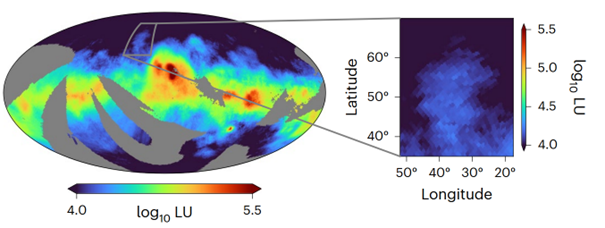Detection of Molecular Cloud within our Local Bubble

The interstellar medium (ISM) is typically divided into distinct regions, each defined by specific properties such as density, temperature, and composition. Among these, molecular clouds represents the densest phase. Comprised mainly of cold, dense molecular hydrogen, they are the primary birthplaces of stars in galaxies. Their high density makes them highly effective at absorbing starlight, causing them to appear as dark voids that obscure both their internal structure and any background light. However, due to the homonuclear structure of molecular hydrogen which prevents dipole transitions, these molecules cannot efficiently re-emit this light. Instead, other molecules, such as carbon monoxide, must be used as tracers to infer their presence. That said, it has long been suspected that fail to adequately capture the extent of molecular hydrogen.
Despite these challenges, a research team led by Blakesley Burkhart has successfully identified one such structure within the Local Bubble, making it the closest such molecular cloud ever discovered. The Local Bubble itself is a sparse region of hot gas, thought to have been carved out by ancient supernovae that swept away the surrounding denser material. This molecular cloud, named Eos, is located near the surface of the bubble at merely 94 pc from the Sun.

Fig 1. FIMS/SPEAR fluorescence map of the sky. Eos is highlighted as a rectangular region in the northern hemisphere.
Eos was detected using data from the FIMS/SPEAR far-ultraviolet (FUV) survey from 2003 to 2005, which was designed to map molecular hydrogen across the universe by identifying its characteristic fluorescent emission. This fluorescence occurs when a hydrogen molecule absorbs a high-energy photon, promoting it to an excited electronic state. As the molecule relaxes, it emits lower energy photons, typically between 912 and 1,700 Å. The Far-ultraviolet Imaging Spectrograph (FIMS) aboard the STSAT-1 satellite collected data across these wavelengths for various sky regions, with an average exposure time of about 2,200 seconds per field

Here, the limitations of the CO tracer became abundantly clear, as only a minor region within the cloud was visible in this band. They estimate the mass of the H2 cloud to be 20–40 M⊙ based on the use of a CO tracer, compared to the substantially larger estimate of 3.4 × 103 M⊙, more indicative of the cloud’s true mass.
From these data, the team developed a theoretical model of the gas to determine the structure’s stability. They found that gravitationally, the cloud did not exceed the Jeans mass and is unlikely to collapse and become a star forming region anytime soon. However, steady state chemical models of H2 abundance within the cloud did not accurately reproduce the observed data. They required a non-steady state model, which instead considers a net production or destruction of molecular hydrogen. They found that H₂ is being destroyed much faster than it’s forming, likely the result of photodissociation by nearby x-ray sources. Their models conclude that the cloud will fully evaporate within the next 5.7 Myr.
--
Journal Source: B. Burkhart et al, A nearby dark molecular cloud in the Local Bubble revealed via H2 fluorescence, Nature Astronomy, (2025), DOI: https://doi.org/10.1038/s41550-025-02541-7
Video map: https://scivis.mpia.de/projects/dustribution/Eos_Cloud/video.mp4
Cover Image Credit: FORS Team, 8.2-meter VLT Antu, ESO
